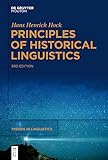Principles of Historical Linguistics / Hans Henrich Hock.
Material type: TextSeries: Trends in Linguistics. Studies and Monographs [TiLSM] ; 34Publisher: Berlin ; Boston : De Gruyter Mouton, [2021]Copyright date: ©2021Edition: 3rd, revised and updated editionDescription: 1 online resource (XXVII, 1074 p.)Content type:
TextSeries: Trends in Linguistics. Studies and Monographs [TiLSM] ; 34Publisher: Berlin ; Boston : De Gruyter Mouton, [2021]Copyright date: ©2021Edition: 3rd, revised and updated editionDescription: 1 online resource (XXVII, 1074 p.)Content type: - 9783110746327
- 9783110746563
- 9783110746440
- 417/.7 23
- P140 .H63 2021
- online - DeGruyter
- Issued also in print.
| Item type | Current library | Call number | URL | Status | Notes | Barcode | |
|---|---|---|---|---|---|---|---|
 eBook
eBook
|
Biblioteca "Angelicum" Pont. Univ. S.Tommaso d'Aquino Nuvola online | online - DeGruyter (Browse shelf(Opens below)) | Online access | Not for loan (Accesso limitato) | Accesso per gli utenti autorizzati / Access for authorized users | (dgr)9783110746440 |
Frontmatter -- Preface -- Contents -- List of figures -- List of illustrations -- List of maps -- 1 Introduction -- 2 Phonetics, transcription, terminology, abbreviations, glosses -- 3 Sound change: The regularity hypothesis -- 4 Sound change and its phonological implications -- 5 Types of sound change -- 6 Analogical and phonological change -- 7 Morphological change -- 8 Semantic change -- 9 Lexical borrowing -- 10 Lexical change -- 11 Syntactic change -- 12 Dialect interaction and dialectology -- 13 Language contact -- 14 Comparative linguistics and reconstruction -- 15 Linguistic change: Its nature and causes -- Notes -- References -- Index
restricted access online access with authorization star
http://purl.org/coar/access_right/c_16ec
Historical linguistic theory and practice consist of a large number of chronological "layers" that have been accepted in the course of time and have acquired a permanence of their own. These range from neogrammarian conceptualizations of sound change, analogy, and borrowing, to prosodic, lexical, morphological, and syntactic change, and to present-day views on rule change and the effects of language contact. To get a full grasp of the principles of historical linguistics it is therefore necessary to understand the nature of each of these "layers". This book is a major revision and reorganization of the earlier editions and adds entirely new chapters on morphological change and lexical change, as well as a detailed discussion of linguistic palaeontology and ideological responses to the findings of historical linguistics to this landmark publication.
Issued also in print.
Mode of access: Internet via World Wide Web.
In English.
Description based on online resource; title from PDF title page (publisher's Web site, viewed 25. Jun 2024)


